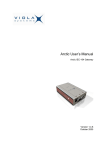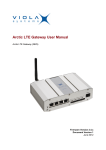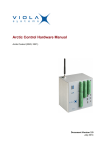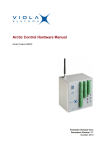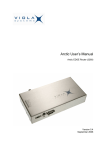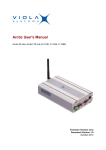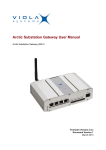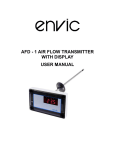Download Arctic Modbus Gateway User`s manual v1.0
Transcript
Arctic Modbus Gateway Arctic Modbus Gateway (2260) Firmware Version x.x.x Document Version 1.0 June 2010 Configuration Manual Arctic Modbus Gateway Copyright and Trademark Copyright © 2008-2010, Viola Systems Ltd. All rights to this manual are owned solely by Viola Systems Ltd. (referred elsewhere in this User’s Manual as Viola Systems). All rights reserved. No part of this manual may be transmitted or reproduced in any form or by any means without a prior written permission from Viola Systems. Ethernet™ is a trademark of XEROX Corporation. Windows™ and Internet Explorer™ are trademarks of Microsoft Corporation. Netscape™ is a trademark of Netscape Communications Corporation. All other product names mentioned in this manual are the property of their respective owners, whose rights regarding the trademarks are acknowledged. Viola Systems Ltd. Lemminkäisenkatu 14-18 A FI-20520 Turku Finland E-mail: [email protected] Technical Support Phone: +358 20 1226 226 Fax: +358 20 1226 220 E-mail: [email protected] Internet: http://www.violasystems.com Firmware Version x.x.x 2 Document Version 1.0 Configuration Manual Arctic Modbus Gateway Disclaimer Viola Systems reserves the right to change the technical specifications or functions of its products or to discontinue the manufacture of any of its products or to discontinue the support of any of its products without any written announcement and urges its customers to ensure that the information at their disposal is valid. Viola software and programs are delivered “as is”. The manufacturer does not grant any kind of warranty including guarantees on suitability and applicability to a certain application. Under no circumstance is the manufacturer or the developer of a program responsible for any damage possibly caused by the use of a program. The names of the programs as well as all copyrights relating to the programs are the sole property of Viola Systems. Any transfer, licensing to a third party, leasing, renting, transportation, copying, editing, translating, modifying into another programming language or reverse engineering for any intent is forbidden without the written consent of Viola Systems. Viola Systems has attempted to verify that the information in this manual is correct with regard to the state of products and software on the publication date of the manual. We assume no responsibility for possible errors which may appear in this manual. Information in this manual may change without prior notice from Viola Systems. Firmware Version x.x.x 3 Document Version 1.0 Configuration Manual Arctic Modbus Gateway Declaration of Conformity (according to ISO/IEC Guide 22 and EN 45014) Manufacturer’s Name: Viola Systems Ltd. Manufacturer’s Address: Lemminkäisenkatu 14-18 A FI-20520 Turku Finland declares that this product: Product Name: conforms to the following standards: EMC: EN 55022 Emission Test (Class A) 1. Radiated Emissions (30-1000MHz) 2. Conducted Emissions (0.15-30MHz) EN 50082-1 Immunity Test 1. IEC 801-3: Radio Frequency Electromagnetic Field 2. IEC 801-2: Electrostatic Discharge 3. IEC 801-4: Fast Transients, AC Power Ports and Signal cables Supplementary Information: “The product complies with the requirements of the Low Voltage Directive 73/23/EEC and EMC directive 89/336/EEC.” Warning! This is a Class A product. In a domestic environment this product may cause radio Interference which may make it necessary for the user to take adequate measures. Manufacturer’s Contact Information: Viola Systems Ltd. Lemminkäisenkatu 14-18 A FI-20520 Turku Finland Phone: +358 20 1226 226 Fax: +358 20 1226 220 Firmware Version x.x.x 4 Document Version 1.0 Configuration Manual Arctic Modbus Gateway Warranty and Safety Instructions Read these safety instructions carefully before using the products mentioned in this manual: Warranty will be void if the product is used in any way in contradiction with the instructions given in this manual or if the product has been tampered with. The devices mentioned in this manual are to be used only according to the instructions described in this manual. Faultless and safe operation of the devices can be guaranteed only if the transport, storage, operation and handling of the devices is appropriate. This also applies to the maintenance of the products. To prevent damage both the product and any terminal devices must always be switched OFF before connecting or disconnecting any cables. It should be ascertained that different devices used have the same ground potential. Before connecting any power cables the output voltage of the power supply should be checked. This product is not fault-tolerant and is not designed, manufactured or intended for use or resale as on-line control equipment or as part of such equipment in any hazardous environment requiring fail- safe performance, such as in the operation of nuclear facilities, aircraft navigation or communication systems, air traffic control, direct life support machines, or weapons systems, in which the failure of Viola Systems manufactured hardware or software could lead directly to death, personal injury, or severe physical or environmental damage. Firmware Version x.x.x 5 Document Version 1.0 Configuration Manual Arctic Modbus Gateway Revisions Date Document Firmware Description of changes Version Version 06/2010 1.0 Firmware Version x.x.x Lay-out changed 6 Document Version 1.0 Configuration Manual Arctic Modbus Gateway Contents COPYRIGHT AND TRADEMARK ........................................................................................ 2 DISCLAIMER..........................................................................................................................3 DECLARATION OF CONFORMITY...................................................................................... 4 WARRANTY AND SAFETY INSTRUCTIONS.......................................................................5 REVISIONS............................................................................................................................ 6 1. INTRODUCTION............................................................................................................... 8 2. PARAMETERS.................................................................................................................. 9 2.1 2.2 2.3 Common parameters.............................................................................................................9 2.1.1 General Settings....................................................................................................... 9 2.1.2 Gateway Mode.......................................................................................................... 9 2.1.3 Protocols....................................................................................................................9 2.1.4 Framing................................................................................................................... 10 2.1.5 Exceptions............................................................................................................... 11 2.1.6 Serial Settings......................................................................................................... 11 2.1.7 Network Settings..................................................................................................... 13 Routes..................................................................................................................................14 Saving Parameters.............................................................................................................. 16 3. CONFIGURING NETWORK MASTER TO SERIAL SLAVES MODE.............................17 3.1 3.2 Settings – Common parameters......................................................................................... 17 Saving Parameters.............................................................................................................. 19 4. CONFIGURING SERIAL MASTER TO NETWORK SLAVES MODE.............................20 4.1 4.2 4.3 Settings – Common Parameters.........................................................................................20 4.1.1 Saving Common Parameters..................................................................................22 Settings – Routes................................................................................................................22 4.2.1 Saving Routes.........................................................................................................24 Making Settings Permanent................................................................................................ 24 LIMITED WARRANTY......................................................................................................... 25 TECHNICAL SUPPORT ..................................................................................................... 26 Firmware Version x.x.x 7 Document Version 1.0 Configuration Manual Arctic Modbus Gateway 1 Introduction This Configuration guide is intended only for configuring Modbus on Viola Arctic device. It therefore presents only Modbus specific functionality. If you need to know more about general Arctic configuration, please refer to Arctic User's Manual. This User's Manual should be shipped with Arctic products or it could be obtained by contacting Viola Systems. The Modbus Gateway is an adapter application enabling conversions between Serial and Network Modbus protocols. The gateway can operate on two modes; either connecting serial Masters to Slaves behind the network or connecting network Master to Serial slaves. The gateway offers following core properties: ■ Supports Modbus RTU and Modbus ASCII serial protocols. ■ Supports ModbusTCP, ModbusRTU over TCP, ModbusRTU over UDP, Modbus ASCII over TCP and Modbus ASCII over UDP network protocols. ■ It can generate and filter out gateway exceptions. ■ It can route traffic on network based on Modbus addressing enabling intelligent use of network resources. ■ Makes automatic connection management. ■ Enables multiple server sessions over network. ■ Offers unlimited amount of Masters on serial or Network side. ■ Offers 30 routes over network to slaves. Firmware Version x.x.x 8 Document Version 1.0 Configuration Manual Arctic Modbus Gateway 2 Parameters The parameters are divided into two groups: ■ Common parameters ■ Routes Common parameters define for e.g. the protocols used in serial and network communications, serial port settings and protocol specific timeouts. Route parameters are only required on Serial Master to Network Slaves mode defining the IP and Modbus addresses of slaves behind the network. 2.1 Common parameters The common parameters define general settings and settings for Network Master to Serial Slaves mode. 2.1.1 General Settings Gateway Status Table 1: Gateway Status Identifier Gateway Status Description Tthe Modbus gateway functionality enabled for the serial port. Values Enabled – Modbus Gateway is enabled Disabled – Modbus Gateway is not enabled Notes 2.1.2 Each serial port of Arctic has it’s own Modbus Gateway definitions. Gateway Mode Table 2: Gateway Mode Identifier Gateway Mode Description The slaves located on network or serial side. Values Network Master to Serial Slaves – Slaves are on serial side. Serial Master to Network Slaves – Slaves are on network side. Notes 2.1.3 If slaves are on network side, the routes are also needed to be defined. Protocols Serial Protocol Table 3: Serial Protocol Identifier Serial Protocol Description Defines the Modbus protocol used on serial communication. Firmware Version x.x.x 9 Document Version 1.0 Configuration Manual Arctic Modbus Gateway Identifier Serial Protocol Values Modbus RTU – Serial devices use Modbus RTU protocol Modbus ASCII – Serial devices use Modbus ASCII protocol Notes Modbus RTU is more efficient and should be used whenever possible. Network Protocol Table 4: Network Protocol Identifier Network Protocol Description Defines the TCP/IP and Modbus protocol used on network communication. Values Modbus TCP – Modbus TCP protocol over TCP Modbus RTU over TCP – Modbus RTU protocol over TCP Modbus RTU over UDP – Modbus RTU protocol over UDP Modbus ASCII over TCP – Modbus ASCII protocol over TCP Modbus ASCII over UDP – Modbus ASCII protocol over UDP Notes 2.1.4 If Viola Systems M2M Gateway is used to tunnel network traffic over SSH, use Modbus RTU over UDP when possible for efficient communication. The SSH tunnel already contains TCP properties like reliable message delivery. Framing Slave Response Timeout Table 5: Slave Response Timeout Identifier Slave response timeout Description Defines the time in microseconds (10E-6 seconds) how long Arctic waits the response from Modbus slave. If the response is not received, Arctic can generate and return Modbus gateway exception. Values 0 – 90 000 000 microseconds (0 – 90 seconds) Notes The reply timeout of Modbus Master must be greater than the Gateway (Arctic) timeout. Otherwise the flow of request-reply communication is violated. Arctic does not accept a new request before the reply from slave is received or the reply timeout is elapsed. The delays in network communication can vary especially in wireless (e.g. GPRS/EDGE/ Mobitex) networks. When the slaves are located on network side, use e.g. PING to estimate the delay packets spend on network. Firmware Version x.x.x 10 Document Version 1.0 Configuration Manual Arctic Modbus Gateway Inter-Frame Timeout Table 6: Inter-Frame Timeout 2.1.5 Identifier Inter-frame timeout Description Defines the idle time in microseconds (10E-6 seconds) that marks the end of Modbus frame in serial communication. If the value is zero, the Gateway uses standard 4 character time. Values 0 … 2 000 000 microseconds (0 – 2 seconds) Notes Use as small value as possible to speed up communication and increase the value if problems arise. Some PC programs can insert unexpected delays between serial characters. Exceptions Generate Gateway Exceptions Table 7: Generate Gateway Exceptions Identifier Generate Gateway exceptions Description Defines does the Gateway generate and return Modbus Gateway exception message to Master if no valid reply is not received from slave. Values Enabled – Generation of Gateway exceptions is enabled Disabled - Generation of Gateway exceptions is disabled Notes This functionality is useful for debugging. See also parameter “Pass Gateway exceptions”. Pass Gateway Exceptions Table 8: Pass Gateway Exceptions Identifier Pass Gateway exceptions Description Defines are the Gateway exception replies from slave side passed to master. Values Enabled – Gateway exception replies are passed to Master Enabled – Gateway exception replies are passed to Master Notes 2.1.6 filtered away Notes Serial Settings Serial Port Table 9: Serial Port Identifier Serial Port Description Defines the serial port that Gateway uses for Modbus serial communication. Firmware Version x.x.x 11 Document Version 1.0 Configuration Manual Arctic Modbus Gateway Identifier Serial Port Values Port 1 – Serial port 1 (RS-232 console/application port) Port 2 – Serial port 2 (RS-232/422/485 application port) Notes If a single serial port or RS-422/485 is required, use Port 2. If Port 1 is used, the console switch of Arctic must be on Application position. DIPswitches below the DB-9 serial connector specify the RS-232/422/485 settings of Port 2. Serial Speed Table 10: Serial Speed Header 1 Speed Description Defines the serial port speed for Modbus communication. Values 300, 1200, 2400, 4800, 9600, 19200, 38400, 57600, 115200 bps Notes Check the speeds supported by connected Modbus equipment. If special serial port speed is required, please contact Viola Systems. Serial Data Bits Table 11: Serial Data Bits Identifier Serial Data bits Description Defines the number of data bits used on Modbus serial communications. Values 5, 6, 7, 8, Auto (8 for Modbus RTU, 7 for Modbus ASCII) Notes Check the data bits supported by connected Modbus equipment. Generally Modbus RTU communication uses 8 data bits and Modbus ASCII communication uses 7 data bits. Serial Stop Bits Table 12: Serial Stop Bits Identifier Serial Stop bits Description Defines the number of stop bits used on Modbus serial communications. Values 1,2 Notes Serial Parity Table 13: Serial Parity Identifier Serial Parity Description Defines the parity method used on Modbus serial communication Firmware Version x.x.x 12 Document Version 1.0 Configuration Manual Arctic Modbus Gateway Identifier Serial Parity Values None – no parity method used Even – even parity bit generated and inspected Odd – odd parity bits generated and inspected Notes Serial Flow Control Table 14: Serial Flow Control Identifier Serial Flow control Description Defines is the hardware (RTS/CTS) flow control used on Modbus serial communication Values Enabled – RTS/CTS flow control used Disabled – RTS/CTS flow control not used Notes 2.1.7 Use of hardware flow control is suggested Network Settings Server TCP/UPD Port Table 15: Server TCP/UPD Port Identifier Server TCP/UDP port Description Defines the TCP or UDP port that Masters can form connections to. Default Modbus TCP/IP communication port is 502. Values 1 - 32500 Notes If multiple Modbus Gateways are running on same device (for both serial ports) the TCP/UDP communication ports must not be same. Use e.g. ports 502 and 504. The network and Arctic firewalls must enable TCP or UDP communication for that port. Maximum Number of Clients Table 16: Maximum Number of Clients Identifier Maximum number of clients Description Defines how many network masters can be connected to Gateway simultaneously. Values 0-20 Notes Generally use value at least 2 when using TCP communication. Otherwise if the Gateway does not recognize partially closed connection, forming of new connections is not accepted by Gateway before “Connection idle timeout” is elapsed. Firmware Version x.x.x 13 Document Version 1.0 Configuration Manual Arctic Modbus Gateway Connection Idle Timeout Table 17: Connection Idle Timeout Identifier Connection idle timeout Description If the connected Master hasn’t sent valid Modbus packets during that timeout the connection is closed by Arctic and therefore the resources are available for new connections. This parameter is especially useful when the network connection is not reliable causing ’hanging’ or partially closed connections. Values 0 – 32500 seconds Notes Set this value about two times the polling interval of master. Enable Keepalive Table 18: Enable Keepalive Identifier Enable keepalive Description Defines is the connection testing enabled for TCP network communication. Values Enabled – Testing the TCP connection with Master is enabled Disabled – Testing the TCP connection with Master is disabled Notes 2.2 The testing is done by sending TCP keepalive packets on certain intervals. Routes When the Arctic Modbus Gateway is configured to Serial Master to Network Slaves mode the routes are needed to be defined for each connected Modbus slave. Gateway can route traffic based on Modbus addressing therefore enabling more efficient communication where each slave receives only data addressed to it. Route in Use Table 19: Route in Use Identifier Route in use Description Defines is this route entry used to decide to which IP address Modbus request is sent. Values Yes – Route information is used No – Route information is not used Notes Firmware Version x.x.x If no route is found for Modbus request is it dropped and Gateway exception is generated if enabled. 14 Document Version 1.0 Configuration Manual Arctic Modbus Gateway Host Table 20: Host Identifier Host Description Defines the IP address or Host name where packets are routed by that entry. Values IP address or Host name Notes If Host names are used the DNS server IP address is required to be defined on Arctic Network settings. The Network Protocol setting on “Common parameters” defines the network- and Modbus protocol used on network communication. TCP or UDP Destination Port Table 21: TCP or UDP Destination Port Identifier TCP or UDP destination port Description Defines the UDP or TCP destination port where this route entry sends Modbus requests. Values 0 – 32500 (Modbus default is 502) Notes The port must be same as used on the network slave device or Gateway behind network. Filter Slave Address Table 22: Filter Slave Address Identifier Filter slave address Description Defines is the routing based on Modbus addresses used for that entry. If not enabled every Modbus request is routed to this entry. If enabled only Modbus requests having destination address matching the Address list of entry are routed. Values Yes – Route entry checks for Modbus destination address No – Route entry enables any Modbus destination address Notes It’s generally good to use Modbus address filtering avoiding unnecessary network traffic. Address to Filter Table 23: Address to Filter Identifier Address to filter Description Comma separated list of the Modbus addresses of slaves behind on this route entry (max. 20 pcs.). Values Maximum 20 pcs. of comma (,) separated Modbus destination addresses. Firmware Version x.x.x 15 Document Version 1.0 Configuration Manual Arctic Modbus Gateway Identifier Address to filter Notes The “Filter Slave address” parameter of Route entry needs to be enabled these addresses to take effect. Connection Idle Timeout Table 24: Connection Idle Timeout Identifier Connection idle timeout Description If there hasn’t been communication on this route during given amount of seconds the Gateway automatically closes the TCP connection to slave and therefore frees Slave’s communication resources. This is especially useful when multiple Masters access same Slave. Values 0 – 32500 seconds Notes Set this parameter about two times the polling interval of Master. Enable TCP Keepalive Table 25: Enable TCP Keepalive Identifier Enable TCP keepalive Description Defines is the connection testing enabled for TCP network communication. Values Enabled – Testing the TCP connection with Slave is enabled Enabled – Testing the TCP connection with Slave is enabled Notes 2.3 The testing is done by sending TCP keepalive packets on certain intervals. Saving Parameters When the settings are complete, press the Apply button and permanently store the parameters by clicking on Commit button. Now reboot the Arctic by pressing Reboot button. The Arctic is now ready to deliver data from Network Masters to Serial Slaves. Firmware Version x.x.x 16 Document Version 1.0 Configuration Manual Arctic Modbus Gateway 3 Configuring Network Master to Serial Slaves Mode When the PLC/RTU slaves supporting serial based Modbus communication are required to be controlled over TCP/IP networks the Gateway on slave side needs to be configured to Network Master-Serial Slaves mode. Figure 1. Arctic Modbus Gateway connecting serial slaves to network On that mode, the Arctic Modbus Gateway acts like network server where Masters (clients) can connect (the default port being 502) and transmit Modbus requests. The Gateway makes conversions between network and serial protocols. If the slave does not reply during defined timeout or if the reply is corrupted, the Gateway sends “gateway exception message” back to Master if the exception generation is enabled. Otherwise, the reply is returned. Multiple masters can connect simultaneously to Gateway, which handles the multiplexing between masters. Note! Each Arctic Modbus Gateway must have a fixed IP address in order the Master to know where to connect. Many client-use optimized networks (like public GPRS, xDSL) does not offer fixed IP addresses but allocate them dynamically. This situation can be solved by using Viola Systems M2M Gateway. 3.1 Settings – Common parameters Only the common parameters are configured. The routes are unused on Network Master to Serial Slaves mode. The configuration menu is located on Applications -> Modbus GW menu of Arctic WEB configuration. Firmware Version x.x.x 17 Document Version 1.0 Configuration Manual Arctic Modbus Gateway Figure 2. Example of common parameters for Network Master to Serial Slaves mode Table 26: Setting guideline for Network Master to Serial Slaves mode Parameter Value Note Parameter Value Note Gateway Status Enabled Gateway Mode Network Master to Serial Slaves Serial Protocol Depends on connected Modbus slave Prefer Modbus RTU when possible Network Protocol Depends on Master side If Viola Systems M2M tunneling is used, prefer UDP based Modbus network messaging. Slave response Depends on connected Modbus timeout slave Increase this value if problem is on serial communication. Inter-frame timeout Increase this value if the problem is on serial communication. Firmware Version x.x.x Modbus RTU protocol has standard timeout of 4 character time. Use value 0 for default. 18 Document Version 1.0 Configuration Manual Arctic Modbus Gateway Parameter Value Note Generate Gateway exceptions Enable or Disable Enabling Gateway Exceptions can help system debugging and testing. Pass Gateway exceptions Enable or Disable Serial Port Select Port 1 or Port 2 Serial Speed Depends on connected Modbus slave. If single serial port or RS-422/485 functionality is required, use Port 2. Serial Data Bits Depends of connected Modbus slave. Use of “Auto” selects 8 data bits for Modbus RTU and 7 data bits for Modbus ASCII. Serial Stop Bits Depends on connected Modbus slave. Serial Parity Depends on connected Modbus slave. Select None, Even or Odd. Serial HW Handshaking Enable if require by slave. Server TCP/ UDP Port Default port for Modbus network communication is 502. Max. Number of clients Normally use minimum value 2. If the network is wireless or If multiple Masters are allowed to unreliable, increase this value connect, then increase the value. if there is a problem during the connection. If multiple Modbus Gateway applications are running on same Arctic, the ports must be different for each Gateway application. Use e.g. ports 502 and 504. Connection idle Set about two times the polling timeout interval of Master. If the polling interval is very long (over hour) use e.g. polling interval+200 seconds Enable keepalive 3.2 Enabled if the polling interval or idle timeout is very long. Saving Parameters When the settings are complete, press the Apply button and permanently store the parameters by clicking on Commit button. Now reboot the Arctic by pressing Reboot button. The Arctic is now ready to deliver data from Network Masters to Serial Slaves. Firmware Version x.x.x 19 Document Version 1.0 Configuration Manual Arctic Modbus Gateway 4 Configuring Serial Master to Network Slaves Mode When Modbus Master supporting serial based Modbus, communication needs to control slaves over TCP/IP network. The Gateway on Master side needs to be configured to Serial Master – Network Slaves mode. Figure 3. Arctic Modbus Gateway connecting serial Master to network On that mode, Arctic Modbus Gateway routes serial Modbus packets to network and performs conversions between serial and network protocols. The routing based on Modbus addressing allows intelligent use of network resources, which is especially useful for pay-per-use networks like GPRS. The settings consist of two parts: ■ Common settings ■ 4.1 Settings for each route Settings – Common Parameters The configuration menu is located on Applications -> Modbus GW menu of Arctic WEB configuration. Figure 4. Example of common parameters for Serial Master to Network Slaves mode Firmware Version x.x.x 20 Document Version 1.0 Configuration Manual Arctic Modbus Gateway Table 27: Setting guideline for Network Master to Serial Slaves mode Parameter Value Gateway Status Enabled Note Gateway Mode Serial Master to Network Slaves Serial Protocol Depends of connected Modbus Master Prefer Modbus RTU when possible Network Protocol Depends of Slave devices If Viola Systems M2M tunneling is used, prefer UDP based Modbus network messaging. Slave response Depends of connected Modbus timeout slave and delays of TCP/IP network. Increase this value if problems on slave communication. Inter-frame timeout Increase this value if problems on serial communication Firmware Version x.x.x Modbus RTU protocol has standard timeout of 4 character time. Use value 0 for default 21 Document Version 1.0 Configuration Manual Arctic Modbus Gateway Parameter Value Note Generate Gateway exceptions Enable or Disable Enabling Gateway Exceptions can help system debugging and testing Pass Gateway exceptions Enable or Disable Serial Port Select Port 1 or Port 2 Serial Speed Depends of connected Modbus Master If single serial port or RS-422/485 functionality is required use Port 2 Serial Data Bits Depends of connected Modbus Master. Use of “Auto” selects 8 data bits for Modbus RTU and 7 data bits for Modbus ASCII. Serial Stop Bits Depends of connected Modbus Master 4.1.1 Serial Parity Depends of connected Modbus Master. Select None, Even or Odd Serial HW Handshaking Enable if require by Master Server TCP/ UDP Port Default port for Modbus network Value is not used on Serial communication is 502 Master to Network Slaves mode. Max. Number of clients Normally use minimum value 2. If multiple Masters are allowed to connect increase the value. Value is not used on Serial Master to Network Slaves mode. Connection idle Set about two times the polling timeout interval of Master. If the polling interval is very long (over hour) use e.g. polling interval+200 seconds Value is not used on Serial Master to Network Slaves mode. Each route entry has it’s own idle timeout. Enable keepalive Value is not used on Serial Master to Network Slaves mode. Each route entry has it’s own keepalive setting. Enable if the polling interval or idle timeout is very long. Saving Common Parameters Before proceeding to Route configuration, save the Common parameters by pressing the Apply button. 4.2 Settings – Routes The route entries define how Modbus packets are routed on network from Serial Master to Network Slaves. Up to 30 routes can be specified each having up to 20 slaves. If the routing is based on Modbus addressing is not required or there are more than 20 slaves behind the route, the address filtering for that entry can be disabled. Firmware Version x.x.x 22 Document Version 1.0 Configuration Manual Arctic Modbus Gateway Figure 5. Route summary The route entry can be edited by pressing Edit button. The routes can also be disabled or enabled by pressing following buttons: Disables the Route entry Enables the Route Entry The active routes do not have strikethrough line. Pressing the Edit button opens following configuration screen: Figure 6. Route edit Table 28: Setting guidelines for Routes Parameter Value Note Route in use Enable or Disable Each IP address and TCP/UDP port of slaves needs to be defined on separate route entries. Host If Host names are used the DNS server IP address is required to be defined on Arctic Network settings. The Network Protocol setting on “Common parameters” defines the network- and Modbus protocol used on network communication. Firmware Version x.x.x The IP address or Host name of slave or Gateway behind the route. 23 Document Version 1.0 Configuration Manual Arctic Modbus Gateway 4.2.1 Parameter Value Note TCP or UDP destination port The TCP or UDP port that slave or Gateway on slave side is listening. Default Modbus port is 502. Filter slave addresses Defines is the routing based on Modbus addresses used for that entry. If not enabled, every Modbus request is routed to this entry. If enabled only Modbus requests having destination address matching the Address list of entry are routed. It’s generally good to use routing based on Modbus addressing in order to avoid unnecessary network traffic. Address to filter Comma separated list (max 20 The “Filter Slave address” pcs.) of Modbus slave addresses parameter of Route entry needs behind this route entry. to be enabled these addresses to take effect. Connection idle timeout (TCP) Set about two times the polling interval of Master. If the polling interval is very long (over hour) use e.g. polling interval+200 seconds. Enable TCP keepalive Enable if the polling interval or idle timeout is very long. Saving Routes When the parameters are configured, press the Route Ready button and proceed to next route. 4.3 Making Settings Permanent When all Routes and Common settings are configured permanently store the parameters by Commit button and reboot the Arctic Modbus Gateway. The Arctic is now ready to deliver data from serial Masters to network Slaves. Firmware Version x.x.x 24 Document Version 1.0 Configuration Manual Arctic Modbus Gateway Limited Warranty Coverage Viola Systems warrants this hardware product to be free from defects in materials and workmanship for the warranty period. This non-transferable, limited warranty is only to you, the first end-user purchaser. The warranty begins on the date of purchase and lasts for the period specified below: : one (1) year Excluded Products and Problems This warranty does not apply to: (a) Viola Systems software products; (b) expendable components such as cables and connectors; or (c) third party products, hardware or software, supplied with the warranted product. Viola Systems makes no warranty of any kind on such products which, if included, are provided "AS IS." Excluded is damage caused by accident, misuse, abuse, unusually heavy use, or external environmental causes. Remedies Your sole and exclusive remedy for a covered defect is repair or replacement of the defective product, at Viola Systems’ sole option and expense, and Viola Systems may use new or refurbished parts or products to do so. If Viola Systems is unable to repair or replace a defective product, your alternate exclusive remedy shall be a refund of the original purchase price. The above is Viola Systems’ entire obligation to you under this warranty. IN NO EVENT SHALL VIOLA SYSTEMS BE LIABLE FOR INDIRECT, INCIDENTAL, CONSEQUENTIAL OR SPECIAL DAMAGES OR LOSSES, INCLUDING LOSS OF DATA, USE, OR PROFITS EVEN IF VIOLA SYSTEMS HAS BEEN ADVISED OF THE POSSIBILITY OF SUCH DAMAGES. In no event shall Viola Systems’ liability exceed the original purchase price of the device server. Some states or countries do not allow the exclusion or limitation of incidental or consequential damages, so the above limitation or exclusion may not apply to you. Obtaining Warranty Service You must notify Viola Systems within the warranty period to receive warranty service. During the warranty period, Viola Systems will repair or replace, at its option, any defective products or parts at no additional charge, provided that the product is returned, shipping prepaid, to Viola Systems. All replaced parts and products become the property of Viola Systems. Before returning any product for repair, customers are required to contact the Viola Systems. Firmware Version x.x.x 25 Document Version 1.0 Configuration Manual Arctic Modbus Gateway Technical Support Contacting Technical Support Phone: +358 20 1226 226 Fax: +358 20 1226 220 E-mail: [email protected] Internet: http://www.violasystems.com Recording Arctic Information Before contacting our Technical Support staff, please record (if possible) the following information about your Arctic product: Product name: ___________________________________________________ Serial no: _______________________________________________________ Note the status of your Arctic in the space below before contacting technical support. Include information about error messages, diagnostic test results, and problems with specific applications. ___________________________________________________________________ ___________________________________________________________________ ___________________________________________________________________ Firmware Version x.x.x 26 Document Version 1.0



























